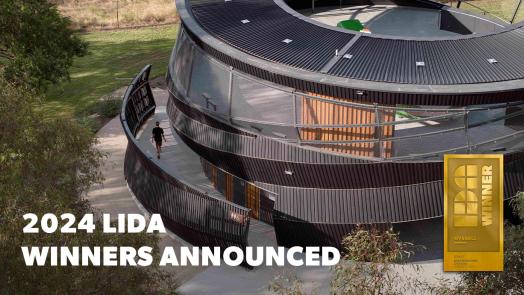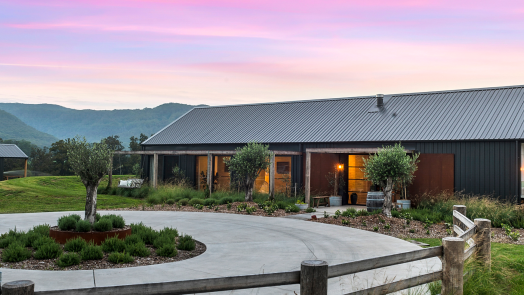
The farmhouse style might look familiar but forget what you know about the classic Australian homestead. For this residence on Bruny Island, architect Fiona Dunin from FMD Architects has taken recognisable shapes and materials and turned them on their head. But until you look closely, you can’t even tell.
The winner of the Regional category in the Lysaght Inspirations Design Awards (LIDA’s), this three-bedroom, two-storey house serves as the residence for a 120ha working farm raising Coopworth sheep, which gives the property its name. Fiona says the owners were adamant about one thing.
“They wanted a compact home that would make the footprint as small as possible because it’s in a working paddock,” she says.
But while it would be mostly just the two of them living there, the house also needed to accommodate family and friends as required. Further discussion revealed the need to make the house wheelchair accessible to make it easier for a close relative to visit. Applying universal design principles from the planning stages had a subtle but profound impact on the design, with the inclusion of wider doorways and seamless thresholds.
“It’s not that difficult,” says Fiona. “It was easy for us to quickly upgrade the design in the planning and layout with things like handrails but it’s also future proofing the place for the owners. It’s something architects should think about more often.”
Despite a climate that includes strong winds and abundant rainfall at times, the clients were keen to avoid a fortress-style design and instead opted for a house that would really live in the environment.
“Down there the weather is so unpredictable with high winds and a lot of rain,” Fiona says. “From Bruny Island the next stop is Antarctica. Accepting that and embracing it rather than sheltering from it was a key driver.”
The plan they settled on was a farmhouse-like design with a pitched roof built on a concrete slab. The north facing living spaces would include leather daybeds set along windows, which could provide sleeping accommodation for visiting grandchildren. A steel pergola to the eastern side provides a spacious alfresco area to take in the morning sun. So far, so standard.
But this house has no eaves and no gutters and the northern side of the house is dominated by floor-to-ceiling windows designed to let the winter sun penetrate deep into the house.
“Without gutters, everything falls down to the ground and there are trenches which direct the stormwater to the dams,” she says. “When it rains, it’s like the water wall at the NGV (National Gallery of Victoria). I didn’t want any issues for the client maintaining the property.”
The very simple roofline and lack of guttering also means there is nowhere for leaf litter to accumulate, an advantage for a property with a (Bushfire Attack Level) BAL29 rating.
The dominant building material choice for the roof and exterior cladding was never in doubt.
“Corrugated LYSAGHT CUSTOM ORB® cladding was the first material we chose,” Fiona says. “It’s lightweight and easy to transport, which was important because everything comes across on the ferry. It’s simple and easy to install and there is zero maintenance.”
The choice of material also allowed for an incredibly elegant dormer window and home office cut-out skylight. In keeping with the deliberate simplicity of the design, Fiona chose to clad the external walls in CUSTOM ORB® manufactured using COLORBOND® steel in colour Terrain®, which further entrenched the building into the local built landscape.
“The colour was really important. I had seen this colour on the island - there are a lot of red shacks around,” she says. “This references those red lead shacks as well as the colour of the earth, which is a terracotta. Everyone loves the red shacks, although most are uninhabitable now, but they are quite beautiful.”
Even the sheep became a part of this build. Given they are raised for meat, the wool is a by-product. Fiona decided to use it in the rafters for its insulation properties. Clear polycarbonate sheeting protects it from insect attack.
“I was thinking about the connection to place,” she says. “The wool is added insulation as well as a decorative feature. It was a total experiment.”
And just in case you missed that you’re on a sheep farm, the sunken bath at the western end of the building has a full length window where the sheep can get up close and personal while you bathe, albeit on the other side of the glass. Like every part of this project, the design of the bathroom is beautifully resolved, referencing the classic farmhouse chimney shape from the exterior.
Hobart-based builder IN2 Construction ran the project and the work was completed in just nine months. “These builders are one of the best in Hobart. Their foreman tapped into a lot of local tradesmen.” What better way to feel at home.
Postscript.
Subsequent to winning the Residential category of the Lysaght Inspirations Design Awards the design also took out first prize in the “Completed Buildings - House & Villa (Rural/Nature)” category at the prestigious 2021 World Architecture Forum – high praise indeed for FMD Architects, the owners and the little farmhouse on Bruny Island.
Photographer: Dianna Snape


